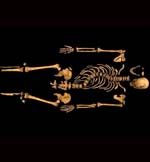Richard III: The truth
Whatever else history discovers about Richard III, his image will always be defined by Shakespeare’s seminal play, said Michael Billington in this piece from October last year


There's a line from a John Ford film, The Man Who Shot Liberty Valance, that has always haunted me: ‘This is the West, Sir. When the legend becomes fact, print the legend.' I thought of it again when reading the extraordinary story about the discovery of a deformed skeleton beneath a Leicester car park. After DNA tests have been completed in December, we shall know whether the remains are those of Richard III. But for those who think this may mark a crucial stage in Richard's rehabilitation, I've got some sobering news: the Shakespearean legend will always outlive the historical fact.
Even now, it's widely accepted that Shakespeare exaggerated Richard's villainy to legitimise the reign of the founding Tudor, Henry VII. In the first volume of his History of England, Peter Ackroyd cites many of the positive aspects of Richard's brief kingship. He was a good lawmaker, a firm administrator and something of a micro-manager in that everything came to his attention even down to ‘the mowing of hay at Warwick'.
Be that as it may, my argument is that the image of Richard created by Shakespeare is so indelibly powerful that it can never be supplanted. It's no accident that virtually every leading actor from Garrick, Kean and Macready up to Olivier, Sir Ian McKellen and Mark Rylance has played Richard.
And not just in Britain. Edwin Booth and John Barrymore were famous American Richards, Fritz Kortner made the part his own in 1920s Germany and I count myself lucky to have seen it played by the towering Georgian actor Ramaz Chkhikvadze, and the nimble-witted Frenchman Robert Hirsch. Kathryn Hunter even proved, at Shakespeare's Globe in 2003, that the role is not the exclusive property of men.
You can see why every actor wants to play the role: it combines a stage-dominating diabolism with Machiavellian cunning and a sharp ironic wit. And, if any one actor could combine all these qualities, it was Sir Laurence Olivier. I never saw his Richard on stage, but I did sit through his film version twice in one day and I was mesmerised by his portrayal of Richard as satanic joker. It's a quality summed up beautifully by Kenneth Tynan in his review of the stage version: ‘I remember the deep concern, as of a bustling spinster with which Olivier grips his brother George and says, with sardonic, effeminate intentness, "We are not safe Clarence; we are not safe"; while, even as he speaks, the plots are laid which will kill the man.'
Olivier's imprint was so strong, and his portrayal of Richard as a malevolent ironist so seductive, that other actors shied away from the role for a long time. Olivier first played Richard at the New Theatre in 1944. And it was 1963 before Sir Ian Holm redefined the role in the Peter Hall-John Barton ‘Wars of the Roses' season at Stratford. Instead of being seen as a star vehicle, the play itself formed the climax of a trilogy in which Richard became the end product of decades of bloodshed between the houses of York and Lancaster.
Sign up for the Country Life Newsletter
Exquisite houses, the beauty of Nature, and how to get the most from your life, straight to your inbox.
to Country Life and save
Hall and Barton were also at pains to point out that Richard, like many 20th-century dictators, achieved power through quasi-constitutional means. I still missed Olivier's devilish energy and wicked wit, but at least the play itself became more comprehensible.
In the half-century since Sir Ian, there has been almost an embarrassment of Richards. But it strikes me that many of them remain an attempt to escape from the Olivier tradition. John Wood at the National, in 1979, was unusual in that he made Richard seem more, rather than less, fascinating as the play progressed and he moved from scarlet cacodemon to a figure of thumb-sucking infantilism. Sir Antony Sher astonished us even more at Stratford in 1984 by playing Richard on crutches, which not only gave him a grass-hopper-like agility, but which variously became phallic symbol, mimic sword and religious cross.
And Sir Ian McKellen gave the character another new twist, in Richard Eyre's 1990 production, by presenting him as a 1930s fascist dictator with a Turkish cigarette constantly depending from his menacing lips and with a capacity for self-adulation as shown by kitsch paintings of the king on horseback.
What is astonishing, as revivals seem to become ever more frequent, is the capacity of actors to find new layers of meaning in Shakespeare's mesmerising double-Gloucester. At the Old Vic last year, in Sam Mendes's modern-dress production, Kevin Spacey gave us a Richard steeped in self-loathing: when Lady Anne succumbed to his seduction, there was a look of disgust in Mr Spacey's eyes that she could find him, as he did not, ‘a marvellous proper man'.
It's also worth noting that Mr Mendes's production was anything but a one-man show and that the play's women emerged with unusual clarity-most especially Haydn Gwynne's Queen Elizabeth, reeling in revulsion at Richard's attempt to enlist her in seeking her daughter's hand, and Gemma Jones's Queen Margaret, who was not the familiar ranting harpy but a stern-faced necromancer.
The most recent Richard is Mark Rylance, who played the role at Shakespeare's Globe this summer in a production that transfers, along with Twelfth Night, to the Apollo on November 7. I think it's safe to say this is the first time in history any actor has combined playing Shakespeare's Richard III and Olivia.
On a first viewing, the most surprising aspect of his Richard was its modesty. This was a withdrawn, slightly apologetic Richard as halting in speech as in gait. Mr Rylance also scooped up a lot of laughs by turning to the audience in a spirit of utter incredulity at his sexual and dynastic success. What I missed, in his portrait of Richard as instinctive loner and runt of the Yorkist litter, was the character's demonism, but I have every hope that what seemed a fascinating sketch at the Globe will turn into a full-blown portrait in the West End.
By then, we should have the results of the tests being carried out at Leicester University on the recently discovered skeleton. But, even if this is proved to be the remains of the real Richard and his physical malformation is shown to be the result of spinal curvature, I don't think it's going to make much difference to the received image. Down the decades, various attempts have been made to offer us a revisionist portrait of Richard, including Josephine Tey's celebrated novel The Daughter of Time. In the end, however, it is the Protean figure in Shakespeare's play who dominates the imagination and who confirms that, given a choice between fact and legend, we prefer to print the legend.
* Follow Country
Life Magazine on Twitter
Country Life is unlike any other magazine: the only glossy weekly on the newsstand and the only magazine that has been guest-edited by HRH The King not once, but twice. It is a celebration of modern rural life and all its diverse joys and pleasures — that was first published in Queen Victoria's Diamond Jubilee year. Our eclectic mixture of witty and informative content — from the most up-to-date property news and commentary and a coveted glimpse inside some of the UK's best houses and gardens, to gardening, the arts and interior design, written by experts in their field — still cannot be found in print or online, anywhere else.
-
 A well-connected rural playground with 23 acres on the edge of the South Downs National Park
A well-connected rural playground with 23 acres on the edge of the South Downs National ParkOld House Farm is an impressive family home with a wealth of amenities that would inspire any rural passion.
By Arabella Youens Published
-
 The UK gets its first ‘European stork village’ — and it's in West Sussex
The UK gets its first ‘European stork village’ — and it's in West SussexAlthough the mortality rate among white storks can be up to 90%, the future looks rosy for breeding pairs in southern England.
By Rosie Paterson Published
